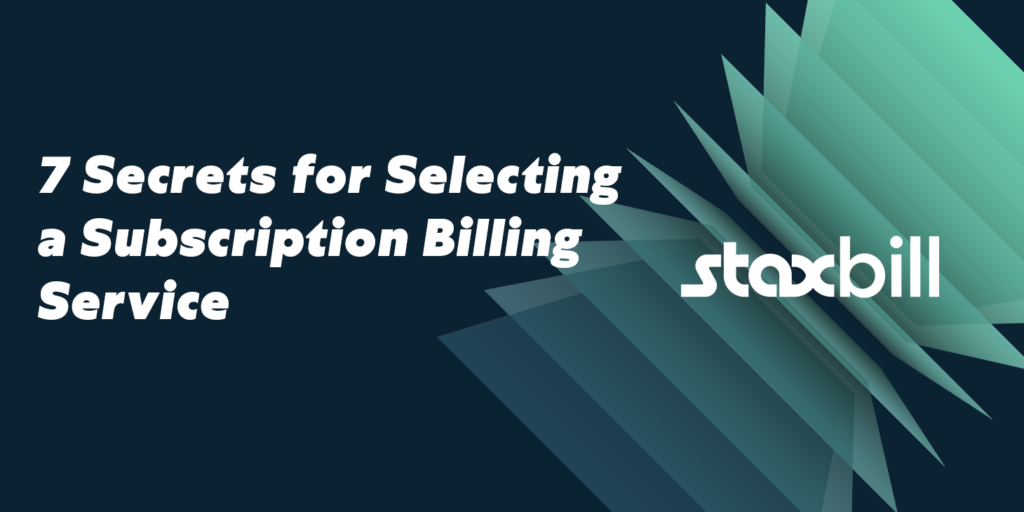Selecting a recurring billing platform is a risky decision. Maybe it’s not exactly a life-or-death scenario, but the wrong choice—or a poorly implemented one—will wreak havoc with your customers, co-workers, and potentially your career. That’s why Stax Bill makes it so easy for you to speak with our live product-experts at all stages of your decision making and implementation journey.
Here are 7 secrets for selecting the right subscription billing service for your recurring revenue business.
1. Plan ahead
You start with a basic outlook on what you need from your subscription business—maybe $10 per month per user? It’s simple to communicate, and you can do the math in your head. It’s a great place to start. But you also need to recognize that your one, simple subscription plan will quickly proliferate as soon as it’s faced with real customers and real market demands. There’s:
- the corporate client that will purchase a lot of users, but needs custom pricing
- the competitor that changes to usage-based pricing
- the client that’s growing and requires international pricing, and
- your marketing team’s desire to introduce bundled pricing.While you can’t predict all the changes that you’ll need to implement, you can predict that you’ll need changes.
2. Get the mechanics right
An incorrect or confusing charge early in the customer life cycle is a prevalent cause of customer dissatisfaction and churn. Spreadsheet-based billing often introduces these types of errors. When you do your billing, be confident you’re charging the right people the right amount at the right time—every time.
3. Be clear with customers
Even if you think your billing is correct, if it doesn’t match your customers’ expectations then it might as well be wrong. Be certain your website and price quotes answer the core questions: what’s being charged, when is it being charged, and for what? With recurring pricing, you need to clarify the following.
- Initial charges that are charged immediately (ie. setup fees, activation fees, etc.).
- Subscription charges (recurring fees)—are they charged in advance, or at the end of the period? Are monthly fees aligned to the calendar month (billing on the 1st or 31st) or does the month start and end on an arbitrary day?
- Usage charges (overages)—when are they incurred, and when are they charged?
4. Don’t rely on credit card statements as your only means of communication
Customers will charge-back even valid charges if they get surprised or confused. Remember, sometimes customers are only familiar with your product name; they don’t always remember your company name. Make sure customers can get receipts and statements on demand and by email. This is especially important if they want to reclaim their costs as business expenses.
5. Deal with credit cards gracefully
Don’t terminate a long-time client just because their credit card expired, or their card number changed—build in grace periods to keep clients longer. You should also warn clients of approaching card expirations and upcoming annual charges.
6. Be able to answer questions easily
Provide your business’s customer agents and sales team with a central place to look for all customer transactions, including charges, refunds, etc. And let them make adjustments that are agreed on with the customer, such as refunds, credits, and discounts.
7. Don’t ignore the analytics
Your recurring billing platform provides critical information about your subscription customers, including their lifetime value, churn, usage, acquisition costs, and more. It also provides necessary information about the financial health of your business, including your earned and deferred revenue, revenue recognition status, and your monthly and annual recurring revenue figures. Look for reports that are easy to generate and understand, and for integration with other commonly used systems and open interfaces to unlock your data and its potential.
Your subscription billing service is a core business system. Not only does all your money flow through it, but for subscription-based businesses, the billing platform is also the dashboard of the business. It should enable you to seamlessly manage your customer lifecycle, and clearly communicate with clients for renewals, upsells, and cross-sells.
Is your business ready for a subscription billing service?
Stax Bill automates invoicing, billing, and collections for subscription-based companies. Ideal for both B2B and B2C businesses, our customers span many industry sectors, including software as a service (SaaS), IoT, digital media, and communications. Our customers rely on Stax Bill to reduce their costs, speed their cash collections, and extend their customer lifecycle.
Connect with one of our billing experts to see how Stax Bill can ignite growth for your business.

